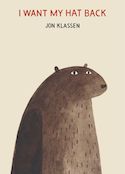
A picture-book delight by a rising talent tells a cumulative tale with a mischievous twist.The bear’s hat is gone, and he wants it back. Patiently and politely, he asks the animals he comes across, one by one, whether they have seen it. Each animal says no, some more elaborately than others. But just as the bear begins to despond, a deer comes by and asks a simple question that sparks the bear’s memory and renews his search with a vengeance. Told completely in dialogue, this delicious take on the classic repetitive tale plays out in sly illustrations laced with visual humor— and winks at the reader with a wry irreverence that will have kids of all ages thrilled to be in on the joke.
- ISBN: 9780763655983
- Author: Klassen, Jon
- Published: 2011, Candlewick Press
- Themes: Animals, Bears, Cumulative tale, growing up, Humor
- Descriptors: Canada, Early Years (ages 2-6), Picture Book
- No. of pages: 38

Angeline:
The author/illustrator, Jon Klassen, creates a story about a bear that lost his hat. I really like the book because this book would be for great readers who are learning how to read. For example, the question the bear asked, “Have you seen my hat?” and “Ok, Thank you any way.” is repeated throughout the book This enables the young readers to learn these words, how to ask questions, and learn the appropriate social skills. The text is simple and [is] color-coded based on the response by the other animal characters. There are six animals whose response relates to the color of the animals. . .particularly the color responding to the bear question. This is great for readers who are learning to understand who is talking through the text. In addition, toward the end of the story, the elk and squirrel [the text is color coded based on the color of the animal] ask the question and the bear responds to the question.
Furthermore, color is important to the story through the text and reflects the feeling of the main character, “the bear.” When he gets angry because he remembered who took his red and pointy hat, the background is colored red [this color signifies angry feelings]. This is so important because it involves the reader with the emotion of the characters through the color of the text. The illustrations bring the story alive!
At the conclusion of the story, the bear is wearing his red and pointy hat, and is alone, after being asked by the squirrel, “Have you seen a rabbit wearing a hat? . . . ” The bear replies, “No, I have not seen the rabbit wearing a hat and I am not to ask him anymore questions.
This is a great story to be read aloud to, either singly or in a group, and of course, this story has lessons to be learned by young readers who are learning about grammar, characters, events, color, as well as responding to the story and the illustrations. The response of the story brings back memories of ones own experience of losing something and how we found it.
Seemi:
I agree with you on many of the points. I found the book to be a great short/repetitive read that many younger and challenged readers would love to interact with and then analyze. The story opens up spaces for dialogue and challenges the reader to review their own sense of ethics and principles of what is right and/or wrong. The simplicity of the layout and design of the setting where the characters act out their roles makes the story easy and welcoming for the audience.
The ambiguity of the ending left a lot where a reader may be either confused or intimidated. The perception of an animal eating an animal is in itself a challenge for a young reader even if it is not a new concept; we see it in age-old folk and fairy tales such as the Aesop’s Fables and Red Riding Hood. So it is really not a new concept but due to the bland expressions of the bear it seems a bit odd.
I have observed Jon’s work and know that Jon draws from fables and writes just to entertain. In a conversation with him he did point out the fact that he does not consider the audience when he writes his books and that he wants to entertain and write simple stories that audiences respond to at an intrinsic level. He draws from his own childhood to write these books. I find his work intriguing and thought-provoking.